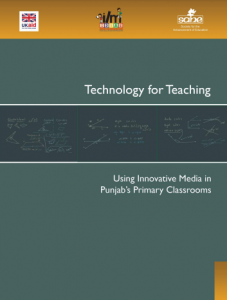 To address the Math content knowledge deficit of students and teachers, SAHE, in partnership with the Department of Staff Development (DSD), initiated this project that used the growing trend of using technology in the classroom as an aid for teaching and learning. Based on weak content knowledge of teachers, student assessment scores, location, and student enrollment, sets of 12 elementary and high schools in 3 districts (Chakwal, Lahore, Vehari) were selected as treatment and control groups. Urdu adaptations were made of 20 videos from Khan Academy and other sources on geometry. These videos were aligned with the National Curriculum, textbooks and DSD teacher guides and introduced to teachers and students through portable pocket-sized projectors.
To address the Math content knowledge deficit of students and teachers, SAHE, in partnership with the Department of Staff Development (DSD), initiated this project that used the growing trend of using technology in the classroom as an aid for teaching and learning. Based on weak content knowledge of teachers, student assessment scores, location, and student enrollment, sets of 12 elementary and high schools in 3 districts (Chakwal, Lahore, Vehari) were selected as treatment and control groups. Urdu adaptations were made of 20 videos from Khan Academy and other sources on geometry. These videos were aligned with the National Curriculum, textbooks and DSD teacher guides and introduced to teachers and students through portable pocket-sized projectors.
The report expands on a number of interesting insights attained through the study. The student assessment survey found that where instructional videos were used, student performance increased, particularly amongst medium and low performing students. Khan Academy videos were better suited for teachers at the primary level while other videos which were less complex videos, were more useful for the students in local classrooms. A satisfaction survey indicated mostly positive perspectives from students and teachers with regard to the innovation. Findings also show that taking videos to the students is feasible where there is access to computer labs, which mostly is the case in high schools. The study recommended that future interventions should focus more on teachers using clusters for cost efficiency and considerations of the local context. Teachers’ input and participation should also be taken into account to ensure ownership of such interventions.
Author(s): Ayesha A. Awan, Muhammad Azhar and Abbas Rashid
Sponsor(s): UKaid, Ilm Ideas 1
